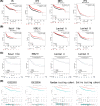X-box binding protein 1 (XBP1): a potential role in chemotherapy response, clinical pathologic features, non-inflamed tumour microenvironment for breast cancer
- PMID: 35543228
- PMCID: PMC9202509
- DOI: 10.1042/BSR20220225
X-box binding protein 1 (XBP1): a potential role in chemotherapy response, clinical pathologic features, non-inflamed tumour microenvironment for breast cancer
Abstract
X-box binding protein 1 (XBP1) is mainly expressed in breast cancer (BC) in human cancers. Its tumorigenesis and favourable prognosis are contradictory, and its essential role in chemotherapeutic response and immunosuppression is unknown in BC. The study firstly identified XBP1 who received neoadjuvant chemotherapy (NAC) from GSE25055 and GSE24460. Associations between XBP1 expression and clinicopathological characteristics was investigated using Oncomine, TCGA, UALCAN and bc-GenExMiner. The prognostic value of XBP1 was assessed using the Kaplan-Meier Plotter, bc-GenExMiner, GSE25055, and GSE25056. Furthermore, we systematically correlated XBP1 and immunological characteristics in the BC tumour microenvironment (TME) using TISIDB, TIMER, GSE25055, GSE25056 and TCGA dataset. Finally, an essential role of XBP1 in chemotherapy response was evaluated based on GSE25055, GSE25065, GSE24460, GSE5846, ROC Plotter and CELL databases. Furthermore, XBP1 mRNA expression levels were obviously highest in BC among human cancers and were significantly related to a good prognosis. In addition, XBP1 mRNA and protein levels were higher in the luminal subtype than in normal tissues and basal-like subtype, which might be attributed to membrane transport-related processes. Apart from BC, negative immunological correlations of XBP1 were not observed in other malignancies. XBP1 might shape the non-inflamed TME in BC. Finally, XBP1 expression was higher in chemo-resistive than chemo-sensitive cases, it had a predictive value and could independently predict chemotherapy response in BC patients receiving NAC. Our study suggests that the essential role of XBP1 in clinical pathologic features, non-inflamed TME, chemotherapy response in BC.
Keywords: Breast cancer; Molecular subtype; Neoadjuvant chemotherapy; Tumour microenvironment; XBP1.
© 2022 The Author(s).
Conflict of interest statement
The authors declare that there are no competing interests associated with the manuscript.
Figures









Similar articles
-
Exon1 and -116 C/G Promoter Polymorphism on the X-Box DNA Binding Protein- 1 Gene is not Associated with Breast Cancer among Jordanian Women.Asian Pac J Cancer Prev. 2019 Sep 1;20(9):2739-2743. doi: 10.31557/APJCP.2019.20.9.2739. Asian Pac J Cancer Prev. 2019. PMID: 31554371 Free PMC article.
-
Identification of DRP1 as a prognostic factor correlated with immune infiltration in breast cancer.Int Immunopharmacol. 2020 Dec;89(Pt B):107078. doi: 10.1016/j.intimp.2020.107078. Epub 2020 Oct 10. Int Immunopharmacol. 2020. PMID: 33049497
-
Combining Immune-Related Genes For Delineating the Extracellular Matrix and Predicting Hormone Therapy and Neoadjuvant Chemotherapy Benefits In Breast Cancer.Front Immunol. 2022 Jul 14;13:888339. doi: 10.3389/fimmu.2022.888339. eCollection 2022. Front Immunol. 2022. PMID: 35911730 Free PMC article.
-
A nomogram to predict pathologic complete response (pCR) and the value of tumor-infiltrating lymphocytes (TILs) for prediction of response to neoadjuvant chemotherapy (NAC) in breast cancer patients.Breast Cancer Res Treat. 2019 Jan;173(2):255-266. doi: 10.1007/s10549-018-4981-x. Epub 2018 Oct 15. Breast Cancer Res Treat. 2019. PMID: 30324273 Review.
-
Complete pathologic response rate to neoadjuvant chemotherapy increases with increasing HER2/CEP17 ratio in HER2 overexpressing breast cancer: analysis of the National Cancer Database (NCDB).Breast Cancer Res Treat. 2020 Jun;181(2):249-254. doi: 10.1007/s10549-020-05599-1. Epub 2020 Apr 10. Breast Cancer Res Treat. 2020. PMID: 32277375 Review.
References
-
- Simons J.M., Jacobs J.G., Roijers J.P.et al. . (2021) Disease-free and overall survival after neoadjuvant chemotherapy in breast cancer: breast-conserving surgery compared to mastectomy in a large single-centre cohort study. Breast Cancer Res. Treat. 185, 441–451 10.1007/s10549-020-05966-y - DOI - PMC - PubMed
Publication types
MeSH terms
Substances
LinkOut - more resources
Full Text Sources
Medical
Research Materials

